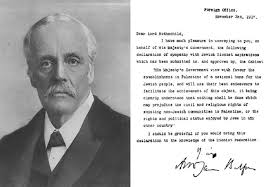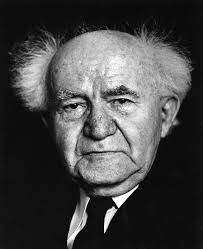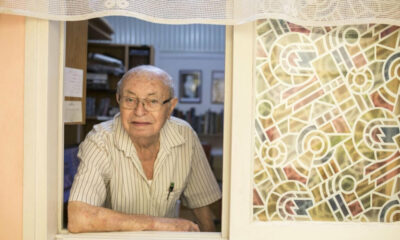Features
Winnipeg and Israel

La vie se rétracte ou se dilate à proportion de notre courage.
Anaïs Nin (1903 – 1977)
By Dr. DAVID HOULT Israel has come of age among the nations of the world. After almost two thousand years of yearning, it can now join the ranks of those that ply power and pain. It is an odd conceit for most of us, for we imbibed so thoroughly from childhood the notions of Jewish vulnerability, suffering and solidarity, the need for self-sufficiency and circling the wagons when attacked. The foundation of a Jewish state came as the Great Hope, a shining star, the salvation from the wreckage of the Holocaust: a Jewish liberal democracy with a military having sterling and stirring ideals standing alone in a rough Middle-East neighbourhood. It appeared to many to be a miracle, and Judaism intertwined with Zionism and state to create a pinnacle of pride and pilgrimage – a tool of God to promote Their divine scheme, and to initiate the return of the Jews to the land They promised to Abraham, Isaac and Jacob.
But now, many of us are troubled. We fear deep down that Israel has gone astray, but are scared to confront the possibility, scared to give The Enemy ammunition if we say anything. So in our pain, we punish those who give even a hint of voicing dissent and fall back on our conceit. We defiantly, and somewhat desperately, have declarations of loyalty and synagogue security committees to keep traitors and Enemies out of our holy places, continue to sing Hatikvah, pray for the IDF and are hyper-vigilant for any sign of anti-Semitism. Underneath though, the stress born of dichotomy grows as we watch the apocalypse that is Gaza, massive demonstrations in Tel Aviv, Jew attacking Jew in Ra’anana, and settlers in the West Bank strutting, scaring, slinging stones and even slaying.

Politically, the seeds of our distress can be traced back over a hundred years to the Balfour Declaration. Based on the anti-Semitic assumption that Jews had great financial clout, it was one long, carefully crafted, vague and contradictory sentence (67 words) designed to enhance British influence in the Middle East. Zionists seized upon the ambiguous phrase “national home for the Jewish people” but carefully ignored the clause “… it being clearly understood that nothing shall be done which may prejudice the civil and religious rights of existing non-Jewish communities in Palestine …”. (Notably, nothing about political rights was included.) Soon, even President Roosevelt was declaring that “Palestine must be made a Jewish State”. Unsurprisingly, there was vocal opposition from most of the local inhabitants (over 90% Arab) and the situation quickly proved untenable. One British historian1 has declared that “measured by British interests alone, [the declaration was] one of the greatest mistakes in [its] imperial history.”
When the British threw up their hands and withdrew from Palestine, the United Nations proposed a partition of the land; the Arab League strongly objected and when the State of Israel was declared in 1948, as every Jewish child knows, the War of Independence began. But by the end of the war, Israel had triumphed; it held about 78% of Palestine and about 750,000 inhabitants had become refugees, a figure confirmed by many Israeli historians. Notwithstanding the details of how they had been exiled, they were not allowed to return. They were scapegoats sent into the wilderness for the sins of the Germans, and it is this refusal that laid the essential foundation of ethnic Jewish statehood – a Jewish majority. And that majority increased: by 1951, the population of Israel was expanded by the immigration of 700,000 Jews, some, ironically, expelled from Arab states in retaliation, thereby enhancing the ethnic imbalance.
I once asked a Palestinian attendee at the Nobel Prize ceremonies in Stockholm for how long her people would try to get their homes and land back and her bitter response was “For ever!” My response was “A bit like we Jews.” But stop for a moment of empathy. In the Talmud, Hillel says: “Don’t do to your neighbour what you wouldn’t have him do to you.” Those 750,000 people suffered the same fate as many Jews under the Romans, traumatised and wretched, filled with hate, anger and despair. But it was war and those sort of rules don’t apply, do they? Do they? For in the aftermath of the Holocaust, Jews were in no mood for the niceties of Torah compassion and empathy: a Jewish state was desperately needed. So what if we didn’t let them back in? Their leaders collaborated with the Nazis, didn’t they? And so the seeds of catastrophe were planted.
If we fast forward, thanks to further wars instigated and lost by the Arabs, Israel now controls almost the whole of what was once Palestine. However, notwithstanding the further exodus of refugees (numbers vary), Jews are no longer in the majority and the presence of so many Palestinians in the West Bank and Gaza represents a huge obstacle to the re-creation of “the promised land”. This is a problem that many in their heart of hearts would love to see go away – but how? By fair means or foul?
Thus we come to the latest attempt to punish Israel which, I believe, is succeeding beyond Hamas’s wildest dreams. Why do I say that? Because Israel’s reaction to Hamas’s attack can be shown to violate its own historical and religious ethics and guidelines for the conduct of war. It places itself, by its own standards, firmly in the wrong and as a result, the nation is tearing itself apart and taking the Diaspora with it. To take just one example, from the Rambam2:

“When a siege is placed around a city to conquer it, it should not be surrounded on all four sides, only on three. A place should be left for the inhabitants to flee and for all those who desire, to escape with their lives.” Or how about the next verse: “We should not cut down fruit trees outside a city nor prevent an irrigation ditch from bringing water to them so that they dry up”? In other words, confinement and starvation are out as tactics of war for Jews.
There is, however, a far more basic, ancient and raw imperative, and that is lex talionis: “An eye for an eye …”. It is found in several places in Torah and also in the earlier Code of Hammurabi. (If you are ever in Paris, do see the stunning Hammurabi stele in the Louvre.) The Pharisees maintained that this law was not to be taken literally and referred to appropriate financial compensation. However, let us be gruesome and take it literally. On one side of the scales of justice we have the killing by Hamas of 1,195 people, the taking of 250 hostages, dozens of rapes and sexual assaults and immeasurable anguish, trauma and misery. What shall we place on the other side of the scale? Let us start with the report by the Associated Press that somewhere between three to four thousand Gazan children have suffered amputations, sometimes without anaesthetics. Meanwhile, the Gazan Health Ministry has released the names of 5,000 children under the age of six who have been killed. Are children The Enemy? We must also add to the balance the thousands of adults who have died and the hundreds of thousands suffering without shelter. We are commanded in the Torah “Justice, justice you shall pursue”. Even if the numbers are exaggerated, is the maiming and killing of children justice? What a wonderful way to create a new generation of terrorists thirsting for revenge!
There are those who claim that the Palestinians are part of the seven biblical nations that Joshua was commanded to wipe out. However, this claim was put to rest as long ago as 100 CE when Rabbi Yehoshua declared that the “seven nations” were no longer identifiable.

Inconveniently, David Ben-Gurion and Yitzhak Ben-Zvi, in a book published in 19183, even believed that the Palestinian peasant population (fellahin) was descended from the ancient biblical Hebrews, and there is some genetic evidence to support this position. Nevertheless, in 2007, Mordechai Eliyahu, the former Sephardi Chief Rabbi of Israel wrote in a letter to Prime Minister Olmert that4 “an entire city holds collective responsibility for the immoral behavior of individuals. In Gaza, the entire populace is responsible because they do nothing to stop the firing of Kassam rockets.”. His son, the chief rabbi of Safed, wrote: “If they don’t stop after we kill 100, then we must kill a thousand. And if they do not stop after 1,000 then we must kill 10,000. If they still don’t stop we must kill 100,000, even a million. Whatever it takes to make them stop.” Only now, however, have a few Gazans had the great courage to protest Hamas, an organisation that in the past has attacked, abducted, tortured and murdered those who stand up to them, including members of the Palestinian Authority5. Would you or I risk torture and death to confront such rulers? I doubt I would have the courage. Would you? Thus does evil ever flourish.
Let us be clear: Gaza is controlled by a vicious fundamentalist movement that in its charter calls for the destruction of Israel. But the more the Gazans are carpet bombed and killed, the more Hamas will gain supporters – young men who have seen mothers, fathers, sisters, brothers and cousins maimed and dismembered and want revenge. Quite apart from questions of morality, the annihilation is just plain dumb!
As the years of this century pass, how shall we possibly believe a new “promised land” could materialise? It would take a new Sodom and Gomorrah. The Arab states have learnt their collective lessons regarding military force and Israel is now Goliath to their slingless David. So, unless Israel feigns weakness (and notwithstanding Iran), it is highly unlikely that a new war will arise to give a pretext for expelling millions from the West Bank. Instead, harassment seems to be the method du jour as new settlements are built, land is appropriated and people are slowly forced into cities and refugee camps, or to other countries such as Canada – to Winnipeg, even. Of course Ben-Gurion’s “peasants” are going to strike back! Is harassment an honourable tactic? Is this loving one’s neighbour as oneself? Ah, but they aren’t neighbours you see, they are The Enemy, for they ambush innocent people and kill pregnant women6. Thus does evil ever flourish.
So here, in a distant country, we sit and watch, a community torn in two. Where do our loyalties lie? As you may have gathered from my quotations, I am a religious Jew who believes that our ethics must be derived from Torah and Talmud. I am a member of a synagogue, but a synagogue that refuses to admit anyone who is perceived to be The Enemy, and a member of a community that states “With Israel, For Israel. Always.” Where do my loyalties lie? Where should they lie? For me, there can no doubt – unequivocally with a Higher Authority, an Authority that demands at the pinnacle of Torah, slap dab in its middle, that I must love my neighbour as myself. That means gently arguing with the racist down the street, having kind words for the Indigenous family pushing back against subtle discrimination and trying to console the Palestinian who is mourning the death of his nephew in Gaza. But there is more.
The Talmud tells us7: “If (anyone) is in a position to protest the sinful conduct of the people of his town, and he fails to do so, he is apprehended for the sins of the people of his town. If he is in a position to protest the sinful conduct of the whole world, and he fails to do so, he is apprehended for the sins of the whole world.” Thus I protest the actions of my synagogue in keeping people out, I protest the actions of my community and I protest the actions of Israel because it is part of this world and it is sinning. It really is that simple – see wrong, protest, for God’s sake (literally), rather than keeping quiet and putting support for Israel first. Torah has an old-fashioned word for such misguided loyalties – idolatry. To quote Abraham Joshua Heschel: “God is not nice. God is not an uncle. God is an earthquake” that shakes us out of our complacency and challenges us first and foremost to reason – to think and analyse, not just feel, using Torah as our guide.
But there is yet more, and it is something we can do in Winnipeg. The same Talmud also states8: “Who is richest of all, …. Some say: One who can turn an enemy into his friend.” And how does one do that? Surely, there can only be one way to begin: by talking – by talking with The Enemy right here in town with empathy for their suffering. That means striving not to be ruled by fear, but taking one’s courage in both hands, being prepared to be made very uncomfortable, to confront other people’s truths. I do not have to agree, I do not have to like it, but I do have to listen. And one day, just possibly, there might be areas of agreement, even friendship, where the seeds of reconciliation are irrigated and can grow and bear fruit, for if God is prepared to reason with us (Isaiah 1, 18), surely we can reason with one another? Can’t we?
___________________________________________________________________________
David Hoult, a physicist who is one of the original developers of the MRI, is the recipient of numerous awards, including the community’s Shem Tov award for his work in helping secure kashrut in the city. He lives in Winnipeg with his wife and children.
1 Monroe, E. Britain’s Moment in the Middle East, 1914–1971. Johns Hopkins University Press (1981).
22 Mishneh Torah, Kings and Wars 6
33 Erets yisroel in fargangenheyt un gegenvart: geografye, geshikhte, rekhtlekhe ferheltnise, bafelkerung, landvirtshaft, handl un industri (The land of Israel past and present: geography, history, legal circumstances, population, agriculture, business, and industry), with three maps of the country and eighty pictures of Israel (New York, 1918),
Hebrew translation, 1980, pp. 196–200 (in Hebrew).
44 Wagner M., Jerusalem Post, May 30th, 2007.
55 https://www.amnesty.org/en/latest/news/2015/05/gaza-palestinians-tortured-summarily-killed-by-hamas-forces-during-2014-conflict/
66 https://www.bbc.com/news/articles/cvgq89yd7p7o
77 Shabbat 54b, 20
88 Avot d’Rabbi Natan 23
Features
Is This the End of Jewish Life in Western Countries?

By HENRY SREBRNIK “Globalize the Intifada” has been the chant echoing through streets since October 7th, 2023. It was never a metaphor, and we now see the gruesome results across the western world, from Australia to Canada: the rise of groups of large, active networks of Islamist and anti-Zionist organizations.
Jews in the West are discovering that the nations they defended, enriched, and profoundly shaped have become increasingly inhospitable. After the Holocaust, explicit Jew-hatred became unfashionable in polite society, but the impulse never disappeared. The workaround was simple: separate Zionism from Judaism in name, then recycle every old anti-Jewish trope and pin it on “the Zionists.”
We have seen the full legitimization of genocidal anti-Zionism and its enthusiastic adoption by large segments of the public. The protests themselves, as they began immediately on October 7th, were celebrations of the Hamas massacres. The encampments, the building occupations, the harassment campaigns against Jewish students, the open calls for intifada, the attacks on Jews and Jewish places have become our new norm. History shows us that antisemitism does not respond to reason, incentive or the honest appeals of the Jewish community.
Outside the United States, there is no Western political establishment with either the will or the capability to address this problem, let alone reverse its growth. I’m sorry to say this, but the future of Western Europe, Canada, Australia, and New Zealand is likely to be increasingly Jew-free.
Today, police stand and watch mobs chant for Israel’s destruction, call for the genocide of its people, harass visibly Jewish citizens, and drive antisemitic intimidation deep into urban life. They now believe their job is to enforce the law only if it does not risk upsetting violent constituencies. This makes Jews expendable, because defending them risks confrontation. This was very clear in the Bondi Beach massacre.
Jews are again donning caps instead of kippot, dressing generically with no cultural markers, and avoiding even a tote bag with Hebrew on it. A corrosive creep toward informal segregation in retail and service sectors is occurring, as Jewish customers report being refused service. A mezuzah hanging from a rideshare mirror leads to cancellations. When Jews express frustration, they are accused of exaggeration or attempting to suppress criticism of Israel. Jewish fear is not treated as a real problem.
“Jews Are Being Sent Back into Hiding,” the title of a Dec. 15 article in the New York Free Press by David Wolpe and Deborah Lipstadt, asserts that the attacks on Jews, including physical assaults, social media campaigns and, most tragically, the recent murders in Australia, are part of a purposive campaign designed to make Jews think twice about gathering with other Jews, entering a synagogue, going to kosher restaurants, putting a mezuzah on the doorpost of their apartments or dorm rooms, or wearing a Jewish star around their necks.
“We know of no one who would consider giving a niece, nephew, grandchild, or young friend a Jewish star without first asking permission of their parents,” they write. The unspoken, and sometimes spoken, question is: “Might wearing a star endanger your child’s well-being?”
Recently, a prominent American rabbi was entering a Target store in Chicago with her grandson, whom she had picked up from his Jewish day school. As they walked into the store the 10-year-old reached up and automatically took off his kippah and put it in his pocket. Seeing his grandmother’s quizzical look, he explained: “Mommy wants me to do that.”
Borrowing a phrase from another form of bigotry, they contend that Jews are going “back into the closet.” No public celebration of Hanukkah took place in 2025 without a significant police presence. Some people chose to stay home.
Lipstadt and Wolpe know whereof they speak. They are respectively a professor of history and Holocaust studies who served as the Biden administration’s ambassador tasked with combating antisemitism, the other a rabbi who travels to Jewish communities throughout the world, and who served on Harvard’s antisemitism task force in the aftermath of the October 7, 2023 pogrom.
What the world has seen over the past two years is a continual, often systematic attempt to terrorize Jews. When political leaders fail to condemn rather than merely “discourage” chants of “globalize the intifada,” we are seeding the ground for massacres like the Hannukah one in Sydney.
If each Jewish holiday will now be seen by antisemites as an opportunity for terror, then the prognosis for diaspora Jewry is bleak. There will be fewer public events, more alarms, more bag checks at doors; there will have to be more security and more police. Unless things change, Jewish life in the diaspora will become more sealed off from the larger society.
Why has this failure come about? Confronting antisemitism, stopping the mobs, challenging the activists, and disciplining antisemitic bureaucrats all carry electoral risk for politicians; Jews are demographically irrelevant, especially compared with Muslim voters, with the U.S. being the only partial exception.
There are those who suggest Jews stop donating funds to educational and other institutions that have turned against us. At this point, I doubt very much that withdrawing dollars will have an impact. For every dollar withdrawn, there will be 100 from Qatar and other sources in its place.
Throughout history, the way a society treats its Jews predicts its future with unerring accuracy. If Jews leave, it will be because a civilization that will not defend its Jews will also defend next to nothing and may itself not survive.
Henry Srebrnik is a professor of political science at the University of Prince Edward Island
Features
Canadian Travel Trends 2025 and the Forecast for 2026

Canadians planning to travel in 2026 should keep an eye on shifting trends and learn what’s coming their way in the new year.
Canadian travel has seen a fair amount of change and instability over the last few years, thanks mostly to the country’s southern neighbours. In 2025, and likely into 2026, travel trends in the Great White North have stabilized significantly, with more Canadians than ever choosing to travel within their own borders. And with 2026 nipping at our heels, let’s take a look at what trends in 2025 have been the most prevalent and how these will shape travellers’ decisions and travel plans in the new year.
Canadian Travel in 2025
Thanks to many factors, including politics, inflation, and airline competition, the majority of travellers opted to explore their own country rather than go abroad in 2025. More local travel money is remaining within the local economy, further bolstering it and making it an even more attractive travel choice. Thanks to the accessibility of private jet charter travel across Canada, luxury local travel has increased as well, with more people looking to immerse themselves in luxury from the start of their journey to the end. When travelling abroad, the U.S. is now the least favoured destination for most Canadian travellers, but Europe saw a significant increase in interest as 2025 progressed.
As local Canadian travel increased this year, it brought with it a drive for local tourists to find their own “Secret Canada” destinations. Far more “off the beaten path” trips were taken, resulting in more travel spending going to smaller or more boutique destinations rather than big city experiences. In 2025, travellers have sought out the wonderful diversity in destinations and landscapes, allowing themselves to access more grounded and authentically Canadian experiences.
Canada’s Government has also encouraged and benefited from local tourism, with initiatives like the Canada Strong Pass offering extra benefits. Initially implemented in the summer, but reintroduced from December 12, 2025, until January 15, 2026, this is a ticket to enjoying the richness of their own culture (iconic natural destinations, museums, train trips) at a discounted rate or even in some cases free of charge.

In the second quarter of 2025, locals took a total of 90.6 million trips that included at least some time spent travelling domestically, which indicated a rise of 10.9% on a year-over-year basis. Of these trips, 58.6 million were day trip experiences (an increase of 12.4%), and 32.0 million were overnight trips or longer (an increase of 8.4%).
Between April and June of this year, Canadian residents spent $20.3 billion on local tourism, which represented a 13.5% year-over-year increase. When undertaking day trips, Canadians spent approximately $101 per visit. On overnight trips, locals spent around $449 per trip, with an average trip length of 2.6 nights. The Great White North is clearly holding its own, and then some, in the international travel market.
Canadian Travel in 2026
As we move towards 2026, many trends from 2025 will remain the standard, but some will evolve to fit changing demands. Across the board, though, the outlook for the coming year is that Canadian travel will become a far more personal thing, with trips being customized to fit travellers’ requirements and desires more closely than ever before. From choosing a hotel that they feel smacks of a beloved destination in their favourite novel, to taking a trip to a destination just to try a snack that’s famously made there and only there, travel is stretching and shifting for the traveller rather than the other way around.
Here are some slightly more specific predictions for the coming year based on the answers of polled Canadians.

- One Gen Z-led trend is the idea of “glowmad travel”. Beauty and skincare are now influencing the places that Gen Z travels, and their trips are far more likely to include visits to skincare and beauty destinations like spas and luxury stores.
- Gen Z adults are helping to drive another trend: family travel as a way to save money. 345 of Gen Z adults polled say that they would take this route.
- More than 70% of Canadians are considering some sort of mountainous getaway in 2026, specifically in summer or autumn.
- 48% of polled Canadians say they would book or consider a destination thanks to the influence of literature.
- More travellers than ever are choosing their destinations based on the accommodations available. 44% of polled travellers say that in 2026, accommodation and what it can offer comes first, and the surrounding destination comes second.
The World Is Your Nova Scotia Lobster Roll
Choose something a little different when you vacation this year. Oysters are great, but a Nova Scotia lobster roll might be more to your taste! Canadians know good travel, so take a maple leaf out of their book and experience something new this year.
Features
Fake IDs and Underage Bettors: The Growing Problem for Sportsbooks
The expansion of legalized sports betting worldwide has resulted in sportsbooks grappling with a problem that they can no longer overlook: the increase in underage individuals using counterfeit identification to place bets. As more and more ways to bet through mobile apps and online sign-ups emerge, minors who are set on their goal are inventing ways to get around age limits. The emergence of this trend is a breach of the law and morality; however, it is also an enormous problem that threatens the very existence of the platforms, which are forced to rigorously obey the regulations .
Why Fake IDs Are Becoming More Sophisticated
Conventional fakes used to be quite simple to recognize—low-quality printing, different fonts for the text, and inconsistent holograms would make them not very reliable for any kind of verification. But counterfeit documents have changed significantly over time. Nowadays, fakes are made better with the help of printing technology and software, and they can even copy barcodes and other scannable features, so their IDs look almost real.
This fact complicates things significantly for sportsbooks, especially those operating online. Most of the time, automated identity verification systems capture a user’s photo and perform basic data matching. In cases where a very good fake ID is used by a teenager who looks older, some systems cannot recognize the trick. Therefore, young bettors have found ways to be able to place wagers through these loopholes.
The Influence of Social Pressure and Online Culture
Social media is a major factor in the increase in risky behavior that minors are engaging in. On various platforms such as Instagram, TikTok, and Reddit, teenagers come across betting slips, parlay wins, and big-payout screenshots that are shared, most probably, by other users. The glamorization of sports betting is leading young people to copy the behavior of influencers, older friends, or even celebrities, as they think that it is the right thing to do.
The competitiveness usually associated with sports is one of the reasons some minors decide to bet on sports. For many, betting becomes another way to engage as a fan—by predicting outcomes, challenging friends, and experiencing the same excitement that adult fans enjoy. Unfortunately, only a small number of minors fully understand the financial risks involved, making them more vulnerable to developing harmful patterns that could continue into adulthood. This is why choosing the most responsible sportsbook, which you can discover more here, is essential. Such platforms provide guidance, enforce safe practices, and ensure regulated play, allowing fans to engage with sports betting in a more informed, secure, and controlled manner.
Sportsbooks Facing Regulatory Pressure
The sportsbooks are being given the task of more closely monitoring and preventing minors from betting on their platforms. If they fail, harsh penalties are possible, including severe fines, loss of a gambling license, and negative publicity that undermines a brand’s trustworthiness. As a result, it is becoming increasingly difficult for people to verify their identities, although this also inconveniences those who are, in fact, legitimate users.
Sportsbooks have to decide between two options that are in conflict with each other: on the one hand, they have to keep the registration process as simple as possible, and on the other hand, they have to carry out age verification in a very thorough manner. The work of balancing is tough, and the underage gamblers are trying all methods to find a way out.
The Rise of Identity Fraud Services
An alarming trend is the emergence of online vendors who openly advertise fake IDs and identity documents. These vendors often claim their products can pass standard sportsbook checks. Some even tailor IDs to specific regions, knowing that certain provinces, states, or countries use verification systems that rely heavily on image comparison rather than live validation.
The availability of these fraudulent services not only empowers minors but also exposes sportsbooks to risks related to stolen identities, money laundering flags, and fraudulent accounts that may later become legal liabilities.
The Consequences for Underage Bettors
While a minor might think that gambling is just a bit of fun without any harm, the outcome can be quite serious. If there is a catching, accounts are closed right away, winnings are confiscated, and parents or guardians, in some cases, are made legally liable for any financial disagreements. Besides that, the risk of developing a gambling problem in the future increases with early exposure to gambling, especially since teenagers are more impulsive and less capable of handling financial risks.
The majority of minors are not aware that sportsbooks keep very detailed records of their activities, including device information and IP addresses. In case a fake ID works one time, using it multiple times will definitely lead to getting caught.
A Growing Problem That Requires Joint Action
Fake IDs and underage betting are issues that have become a major challenge in the industry, and no single stakeholder can solve these problems on their own. Sportsbooks need to enhance their identity verifications, regulators should get prepared for new types of fraud, technology providers have to come up with new solutions more quickly, and parents should always be aware of what their children are doing online. The industry’s rapid development is making this problem more and more urgent because the number of minors trying to get around the safety measures is increasing.
Sports betting can serve as a fun and legal form of entertainment for adults, but the need to protect the youth is what defines the industry and ensures its survival in the long run. As the quality of fake IDs keeps improving and the online culture is more and more inclined to consider betting as a normal activity, sportsbooks must ensure that underage users do not have access and that the environment is safe for all users. They need to do this now more than ever.





